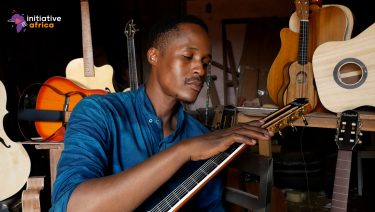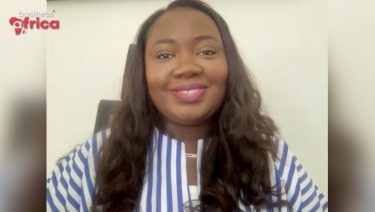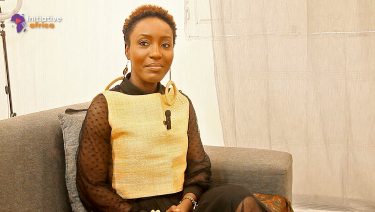Slaves No More

[Antoine Lamoraille : Trapu misi ya nenge kondre, te i si bendi dede udu da mi mu fele, « Tu as su éviter le piège qui a pris tes frères, désormais méfie-toi de l’arbre qui penche ». Acrylique sur bois massif, 200 x 80 cm. Coll. Mama Bobi.]
By Heidi Ellison
The fascinating story of the Maroons of French Guiana and Suriname is told through their applied and visual arts in the exhibition “Marronnage: L’Art de Briser ses Chaînes” at the Maison de l’Amérique Latine (through September 24, 2022) in Paris.
Who are the Maroons? They are the descendants of people who were rounded up from different parts of Africa in the 17th and 18th centuries and shipped to the two South American countries to work as slave laborers on plantations. Refusing to accept this terrible fate, they revolted and disappeared into the Amazonian forest, where they built villages that have survived the centuries in spite of the slave-owners’ brutal but ultimately more or less futile attempts to find them and bring them back to the plantations. In their hidden villages, these disparate peoples built a new life that required them to develop a language and culture. Tempe (art) was – and still is – a vital component of that world. The exhibition celebrates their culture by displaying both historic and contemporary pieces. The former are beautifully decorated everyday or ceremonial items, including combs, pagnes, paddles and platters.
Interpretations of historical designs

The contemporary works on exhibit, many of them painted on paper or canvas rather than on houses, doors or other near-to-hand supports as in the past, show the influence of the Maroon culture as interpreted by 13 talented artists, who are still very much attached to their villages and unique culture. They freely interpret the colorful intertwining designs found on traditional objects, but today they have access to a wide range of materials and colors that were not available to their predecessors.
The sophistication of the historical objects is striking. The combs, intricately carved in wood by men, were traditionally given to their wives and lovers. One of the participating artists, Carlos Adaoudé, known as Kalyman, who was born in the village of Papaichton, French Guiana, remembers a particular comb that had been given to his grandmother by her first husband. “She never used it,” he said at the opening of the exhibition, “but she would take it out from time to time and stroke it.” Such objects are now also made for sale to tourists, but they retain their meaning for the Maroons. “What’s important is not the object but what it says,” said painter Antoine Dinguiou, citing Antoine Lamoraille, an Aluku artist and activist.
Influence of Africa

Groupe d’esclaves débarquant du bateau de négriers. Port de Paramaribo. Coll. Jean-Paul Duviols.]
What remains of the African heritage of the people stolen from their homes and “marooned” in South America centuries ago? “There are traces of African society,” said historian Geneviéve Wiels, one of the exhibition’s curators, “but since slaves from different countries were mixed together, no one country was dominant.”
The other curator, anthropologist Thomas Mouzard, pointed out that the slave owners were careful not to bring people from the same groups together so that they wouldn’t speak the same language. “It was a tactic to prevent revolts,” he said, adding that the works on show are “original creations, creolizations based on individuals’ memories of different societies in Africa, sometimes even East Africa.”
The poetry of these works, both new and old, lies in the deep meaning they still hold for the Maroons. As the French anthropologist and geographer Jean Hurault said in 1970, “The tradition asks [the artist] to put the best of himself into the decoration of even the most humble object.”
See also

Menoosha Muziki – Vocal coach
She is a talented vocal coach and singer. Originally from Côte d'Ivoire, with roots in Cameroon, Menoosha has lived and worked between Germany and France. She advocates for the concept of overcoming trauma through music.

Harmony and passion: the journey of a violin-maker in Cameroon
Luthiery, the age-old art of making stringed instruments, is getting a new lease of life in Cameroon thanks to Clovis Tchoufack. Based in Douala, this visionary craftsman combines tradition and innovation to create unique guitars that are making their mark on the country's musical scene. From a passion born of heartbreak, Clovis has built a flourishing career, becoming a benchmark to be reckoned with.

Puntland battles piracy to protect economy
Resisting a new wave of maritime piracy in eastern Somalia is the number one priority for Puntland's maritime police force.

Aissatou Ami Touré – mobile banking and inclusive finance
Aissatou Ami Touré, Managing Director of Yassir Senegal, an Algerian e-commerce start-up. The company offers digital financial services, enabling users to pay, save and borrow, in addition to e-commerce and delivery solutions. During this interview, Aissatou discussed the challenges of mobile payments for e-commerce in Africa. She was awarded the Les Margaret Prize 2024 in the Africa category, organised by the Journée de la Femme Digitale (JFD).



